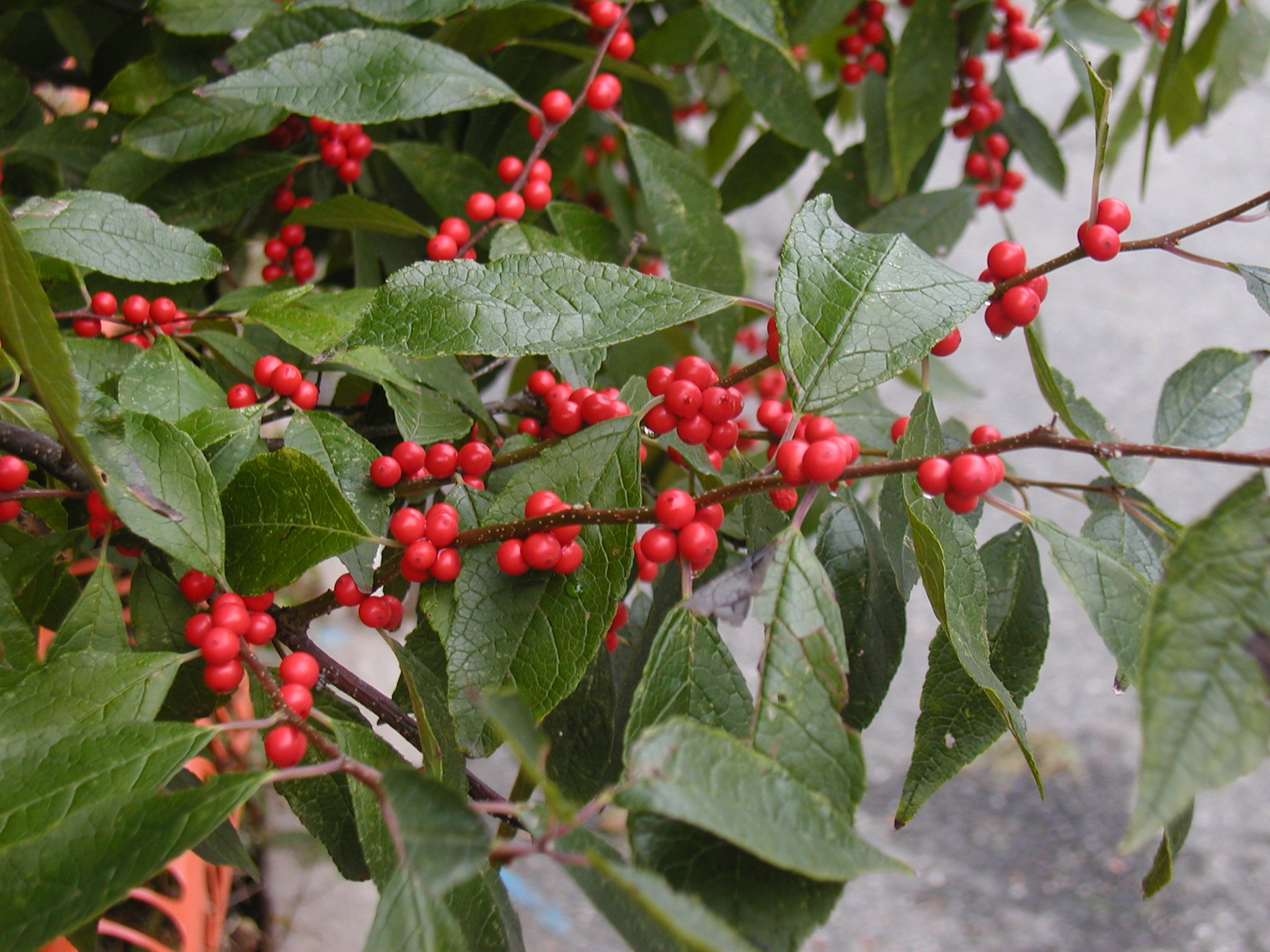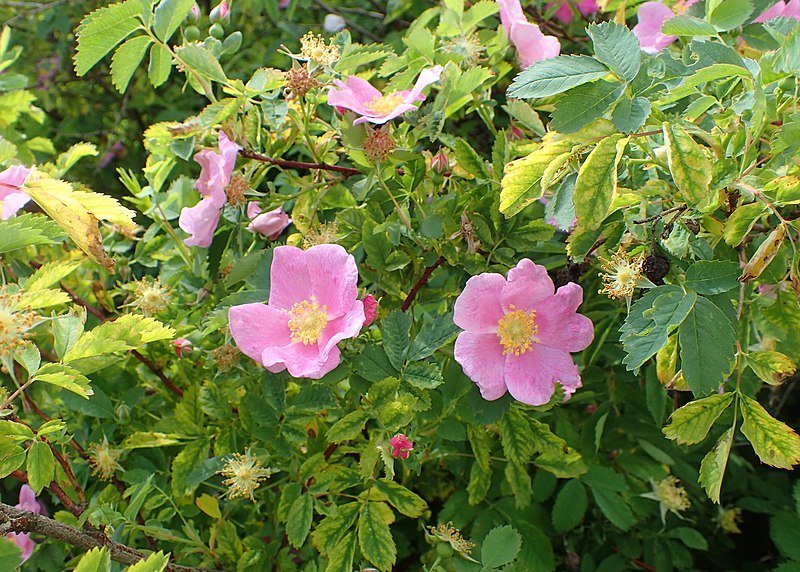30 Native Shrubs For Ontario Gardens
Your go-to reference for the best shrubs for gardeners and wildlife
Native shrubs are an indispensable part of your natural garden, providing extended season interest, privacy screening, high wildlife value and beauty.
For gardeners looking to attract birds, shrubs are a must! They provide valuable nesting habitat, nutritious fruit and a bounty of insects to feed young with.
In this article, I have picked the best shrubs for Ontario gardeners based on wildlife value, growth characteristics and commercial availability. Lets get right into it!
Native shrubs for your garden:
Hint: Use “ctrl+F” then type in the growing condition you’re looking for (i.e shade) to search for plants by characteristics.
Canada Serviceberry (Amelanchier canadensis)
Growing Conditions: Part shade to full sun, average moisture needs. Up to 8m tall x 4.5m wide.
Serviceberry offers versatility and multi-season value to gardeners and nature.
Copious white blooms in early spring become reddish-purple berries by mid summer. The foliage turns wonderful hues of orange in the fall. Great for supporting pollinators and songbirds.
Typically multi-stemmed with an upright vase shape.
Also try: Saskatoon Serviceberry (Amelanchier alnifolia), Smooth Serviceberry (Amelanchier laevis) or Running Serviceberry (Amelanchier stolonifera).
Growing Conditions: Full sun to part shade, wet to average soils; adaptable to soil type; 2.4m tall x 1.8m wide.
Chokeberry finds its origins in wetlands but it is very adaptable to most gardens as long as the soil doesn’t go bone-dry.
Showy clusters of white flowers in the spring. Flowers turn into dark purple berries that, despite its name, are edible for humans and birds alike.
Upright, mounded form with a suckering habit in moister soils. A good choice for clay soils and wildlife hedges.
Growing Conditions: Sun to part sun; dry to average, well-draining soils; 1.2m tall x 1.5m wide.
A drought tolerant, low-growing shrub with huge wildlife value.
Copious white flower clusters bloom in early-summer and feed solitary native bees and hummingbirds! Flowers fade into attractive clusters of hard seeds that provide winter interest.
A deep taproot makes it hard to move, so choose its location wisely!
Salt and pollution tolerant. The leaves make a pleasant tea and are a host plant for the Spring Azure, Summer Azure and Mottled Duskywing.
Buttonbush (Cephalanthus occidentalis)
Growing Conditions: Full to part sun; moist to wet, rich soils; 3.6m tall x 2.4m wide.
A multi-stemmed shrub with a rounded to slightly irregular form. Unique, globular flowers are fragrant and highly attractive to pollinators. The globular seed heads feed birds, especially waterfowl.
A perfect choice for rain gardens, shoreline planting and erosion control. Tolerates clay soil. Don’t let it dry out.
Bunchberry (Cornus canadensis)
Growing Conditions: Shade to part shade; moist, rich, well-drained soil; 22cm tall.
Despite its small stature, bunchberry dogwood is in fact a shrub, finding its origin in cool, moist forests.
Best used as a groundcover in shady gardens. Whorls of lush leaves are topped by white spring blooms. Clusters of red berries form once the flowers fade. Great for native pollinators and feeding birds.
Leaves turn into wonderful shades of red/burgundy in the fall.
Pagoda Dogwood (Cornus alternifolia)
Growing Conditions: Shade, part shade, part sun; rich, moist to average soil; 7.6m tall x 9m wide.
A classic native shrub for shade! Valued by gardeners for its attractive, horizontally spreading branches. Clusters of white flowers in spring, followed by late summer berries that feed migrating birds.
Pruning may destroy the unique pagoda-like form. Usually a single-stemmed shrub. Tolerates acidic soils.
Gray Dogwood (Cornus racemosa)
Growing Conditions: Sun to part shade; moist to slightly dry, well draining soil; 4.5m tall x 4.5m wide.
A suckering, multi-stemmed shrub often found near water but is adaptable to a variety of settings.
Showy clusters of white flowers are found at the ends of its branches in late spring. These flowers mature into white berries in late summer that contrast beautifully with the purplish/red fall foliage.
Excellent for pollinators, birds and wildlife hedges. Note that it likes to sucker so it may not be suitable for small gardens.
Tolerant of clay soil and air pollution.
Red Dogwood (Cornus sericea)
Growing Conditions: Sun, part sun or part shade; wet to average soils, prefers fertile soils; 3m tall x3m wide.
Red Dogwood has already made a name for itself in gardens for its year-round interest, adaptability and high wildlife value.
Clusters of white flowers feed pollinators in the spring then mature into porcelain-white berries that are enjoyed by birds.
Of course, this native shrub is famous for its brilliant red twigs that create stunning winter interest. Prune a few of the largest stems every year to maintain vigor of the red stems. Grows well in clay soil. Spreads by suckering.
Also try: Silky Dogwood (Cornus amomum)
American Hazelnut (Corylus americana)
Growing Conditions: Sun to shade; moist to average soils; 3.6m tall x 2.4m wide.
A highly recommended shrub for multi-season interest and wildlife value. Edible, ornamental and versatile.
Yellow catkins dangle elegantly from the branches in early spring. Pollinated flowers mature into edible hazelnuts, great for humans and wildlife alike. Leaves turn awesome shades of red/burgundy in the fall.
Host plant for many species of butterflies and moths. Dense growth and suckering habit creates an excellent privacy hedge and nesting habitat for birds. Tolerates clay soil.
Also try: Beaked hazelnut (Corylus cornuta)
Bush Honeysuckle (Diervilla lonicera)
Growing Conditions: Sun to shade; average to dry soil; 0.9m tall x 1.2m wide. Adaptable.
We can’t get enough of this amazing shrub! Its low height, adaptability and suckering habit makes it an excellent groundcover choice for a variety of gardens.
Tubular yellow flowers appear in mid-summer and are visited by native bees and hummingbirds.
Dark green leaves fade to hues of orange and red in the fall
Grows well in both clay soil and shallow, rocky soil. Moderate salt tolerance.
Witch Hazel (Hamamelis virginiana)
Growing Conditions: Part shade to shade; moist to average soil; 4.5m tall (10m in ideal conditions!) x 6m wide.
This small tree, to tall shrub, spreads outwards with a slightly irregular form, smooth gray bark and dark green leaves.
Unique blooms with long, twisted petals persist late into the fall, even as all the golden-yellow leaves have fallen.
The seeds are popular with birds such as goldfinches.
Tolerates shade, pollution and poor soil. Fragrant flowers.
Rose Mallow (Hibiscus moscheutos)
Growing Conditions: Sun; wet to average; 2m tall x 1.2m wide
Despite looking tropical in origin, this shrub is in fact native to Ontario! Rose Mallow will do well in most gardens if the soil doesn’t go bone-dry.
Fabulous, large, pinkish-white flowers with burgundy centers bloom for about a month in mid-late summer.
Supports hummingbirds and many native bees, including the specialist rose mallow bee. Leaves host multiple species of butterfly and moth.
It emerges late in the spring, so don’t give up on it too soon!
St. Johns Wort (Hypericum kalmianum)
Growing Conditions: Sun to part sun; dry to average; 90cm tall x 90cm wide.
A low maintenance, compact shrub with a wonderful bushy form. Prefers moist, well drained soils but is tolerant of rocky soils and drought.
Copious yellow flowers bloom for up to 6 weeks in mid summer and attract bumblebees and sweat bees from far and wide.
A perfect choice for small gardens, borders or being massed in formal gardens.
Grows in clay soil. Slow growing but worth the wait.
Salt tolerant.
Winterberry (Ilex verticillata)
Growing Conditions:Sun to part sun; Wet to moist soil; 2.4m x 2.4m
Winterberry is a multi-stemmed shrub with an an attractive, upright form and suckering habit. It grows relatively slowly but we think it’s worth the wait (so do the birds!).
The greenish/white flowers bloom in early summer and are popular with bees.
It is hard to beat winterberry for its winter interest. Not only do the shiny red berries contrast vividly with the snowy landscape but they also provide a valuable winter food source for birds, especially cedar waxwings.
Only female shrubs will produce berries and require a male nearby to do so.
Tolerates acidic soil and shallow standing water. Consider adding a thick layer of wood chips around the base to maintain moisture.
Spicebush (Lindera benzoin)
Growing Conditions: Shade to part sun, moist to average, 3m tall.
Spicebush is a shade tolerant shrub that is adorned with yellow flowers in early spring. Flowers turn into bright red berries by late summer and make a great food source for migrating birds.
Leaves and twigs have a pleasant fruity aroma while the berries smell like allspice (and can be used in much the same way). Host plant for spicebush swallowtail butterfly.
A great replacement for non-native forsythia! Tolerates clay soil. Usually multi-stemmed but doesn’t sucker aggressively.
Sweetgale (Myrica gale)
Growing Conditions: Full sun, wet to moist,1.2m tall X 1.5m wide.
A multi-stemmed, aromatic shrub with nitrogen fixing capabilities and a mounding form. Excellent for moist areas and wetland rehabilitation and will grow well in your bog garden.
Sweet Gale spreads by suckers and by branch layering. The leaves can be used to make teas or scent soaps. Line your blueberry buckets with the leaves to stop the berries from spoiling.
Provides food and nesting sites for birds while hosting several species of moth larvae. Flowers are wind pollinated.
Ninebark (Physocarpus opulifolius)
Growing Conditions: full sun to part sun, dry to average, rocky soil, 2.7m tall X 2.7m Wide
Ninebark is a fast-growing, multi-stemmed shrub with attractive, peeling bark.
In early summer Ninebark comes alive with hundreds of rounded clusters of small white flowers. These flowers attract pollinators like no other!
Dense growth makes good nesting habitat and privacy screen. Birds will eat the seeds through the winter months.
Can be pruned to maintain smaller form. Does not spread aggressively but may self-seed.
Sand Cherry (Prunus pumila)
Growing Conditions: Sun to part shade, dry to average, sandy or rocky soil, <3m tall X 2m wide.
If you need a shrub that will preform well in dry, sandy soil, then look no further!
Sand Cherry is a tough, multi-stemmed shrub with a low, spreading growth habit.
Fragrant white flowers attract a diversity of native bees in the spring. Flowers fade into edible cherries for humans and birds alike.
Wonderful fall colour as it turns shades of red, orange and burgundy.
Fragrant Sumac (Rhus aromatica)
Growing Conditions: Sun to part sun, dry to average, shallow or rocky soil, 1.8m tall X 3m wide
Fragrant sumac is a dense, low growing shrub that spreads reliably by suckers. Great for foundation plantings.
Attractive yellow flowers in the spring are wind pollinated and not of much use to pollinators. However, they turn into vibrant red berries in the fall.
Berries feed birds during the winter months when little food is to be found elsewhere. The dense growth provides shelter for beneficial wildlife.
Excellent fall colour as its leaves turn stunning shade of red, burgundy and yellow in the fall.
Grows well in clay. Non-poisonous.
Smooth Rose (Rosa blanda)
Growing Conditions: Full sun, dry to average, 1.5m tall X 1.5m Wide.
Smooth Rose is a vigorous, nearly thorn-less rose with a dense, mounding form.
Great for erosion control on dry hillsides. Can be pruned to maintain a smaller size.
The showy summer blooms support many species of native pollinators. In addition, roses are host plants for 139 butterfly/moth species!
Flowers fade into rose hips that provide a splash of red in the late fall/winter landscape.
Purple Flowering Raspberry (Rubus odoratus)
Growing Conditions: Full sun to full shade, dry to average,1.8m tall X 3.6m wide.
Purple flowering raspberry is a fast-growing, adaptable, suckering shrub that will grow in full sun to full shade.
Grow in full sun to maximize dense growth and flowers.
Cheery pink flowers bloom through out summer and support mainly bumblebees.
Flowers fade into flattened raspberries that are delicious and edible for humans and wildlife.
Hollow stems provide nesting sites for native bees. Prune like commercial raspberries.
Pussy Willow (Salix discolor)
Growing Conditions: Full sun, wet to average, 7m tall X 4m wide.
Pussy Willow is a suckering, multi-stemmed shrub adapted to wet areas but will tolerate average soil moisture in your garden.
Great for a quick-growing privacy screen or hedge. Can easily be pruned to control height. Easily propagated by cuttings.
Soft-looking, yellow blooms are a welcomed sight that spring has sprung! A crucial early food source for the first pollinators of the season.
Willows are host for 455 butterfly/moth species!
Sandbar Willow (Salix exigua)
Growing Conditions: Sun, part shade, wet to moist, sandy soil, 4.5m tall and wide.
Sandbar willow is a fast growing, suckering shrub for wet areas and shallow standing water although it will tolerate drier soils once established.
Prolific suckering makes it a smart choice for shoreline restoration, erosion control and privacy hedges but maybe not the best choice for a small garden.
Narrow, gray-green leaves lends a delicate texture to the landscape.
Prune to keep small. Tolerant of urban pollution.
Willows are host for 455 butterfly/moth species!
Canada Elder (Sambucus canadensis)
Growing Conditions: Sun to part shade, wet to average, 3.6m tall and wide.
A fast growing, suckering shrub with lacy foliage and a large stature.
Great for erosion control and privacy screens and is fairly adaptable to drier conditions and multiple soil types.
Showy, flat-topped, white flower clusters in early summer are popular with all kinds of pollinators.
The hollow stems provide nesting opportunities for native bees.
Flowers turn into showy clusters of dark purple/black berries that are edible for birds and edible/medicinal for humans (not when raw).
Red Elder (Sambucus racemosa)
Growing Conditions: Shade, part sun, moist to dry, tolerates rocky soil, 1-6m tall X 2-4m wide.
A shade tolerant, multi-stemmed shrub with a globular form and fast growth habit.
Takes on a more open form in shade and a more dense form in sun.
Showy white flower clusters in the spring turn into bright red berries in the fall. Excellent for supporting pollinators and birds.
Hollow stems provide nesting cavities for native bees.
Meadowsweet (Spiraea alba)
Growing Conditions: Sun, part shade, moist to average, 1.8m tall X 1m wide
A multi-stemmed shrub with unbranching stems topped with showy clusters of white flowers over summer months.
Adapted to wet soils but will grow in average moisture conditions once established. Works well in more formal gardens.
Brown fruit persists after flowers fade to create excellent winter interest.
Golden-yellow foliage in the fall.
Snowberry (Symphoricarpos albus)
Growing Conditions: Sun or shade, average to dry 1.5m tall X 1.8m wide
An adaptable low growing, suckering shrub with blue-green foliage and and a fast growth habit.
Good for foundation plantings. Can be pruned to maintain a “neater” look.
Tiny pink flowers bloom throughout the summer then give way to large white berries that persist through winter months.
Flowers benefit bumblebees, humming birds and hummingbird moths. Host plant for hummingbird moths.
Low bush Blueberry (Vaccinium angustifolium)
Growing Conditions: Sun, average moisture, acidic soil, 60cm tall and wide
A wonderful, low-growing shrub with a long season of interest. Grows well in acidic soils.
White, pink-tinged flowers in early spring are a hit with bumblebees. Flowers give way to delicious, edible blueberries.
Stunning fall colour with vibrant shade of red and burgundy.
Blueberries are hosts for 288 butterfly/moth species!
Arrowwood (Viburnum dentatum)
Growing Conditions: Sun to part shade, wet to average, tolerates clay soil, 2.4m tall and wide.
A multi-stemmed shrub with an elegant form and fast growth.
Showy, flat-topped clusters of white flowers in early summer are followed by blue berries in the fall.
Bold, green leaves change to wonderful colours of red in the fall.
Great for a privacy screen and for bird nesting habitat. Can be pruned right after flowering.
Nannyberry (Viburnum lentago)
Growing Conditions: Sun to part shade, moist to average, 4.5m tall X 3m wide.
A reliable shrub with an elegant form and hardy nature. Has a manageable suckering habit.
Large clusters of showy white flowers in the spring give way to dark blue fruit in the fall. Great for both pollinators and birds!
Excellent fall colour as the dark blue berries contrast the deep red foliage.
Great as a privacy screen and for bird nesting habitat.
Can be pruned after flowering.

































